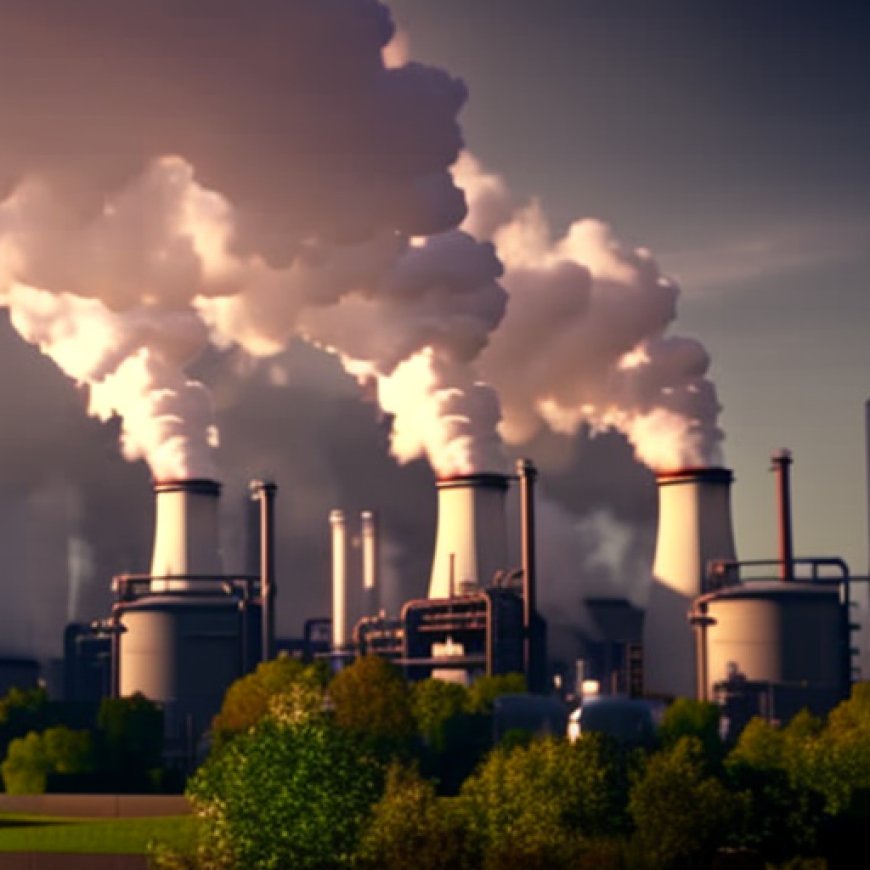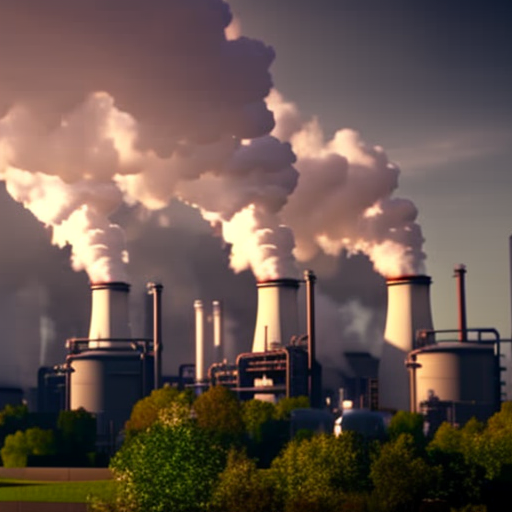EPA limits toxic air pollution from chemical plants
EPA limits toxic air pollution from chemical plants The Washington Post


Sustainable Development Goals (SDGs) and the Fight Against Industrial Air Pollution

Introduction
Five months after moving into her home in Texas City, Tex., encircled by industrial facilities, Nina Patton was diagnosed with breast cancer. She wondered if the pollution billowing from these plants was to blame.
EPA Finalizes Rule to Reduce Cancer-causing Gases
Cancer-causing gases and other toxic air pollution from chemical operations in Patton’s community — and others like it nationwide — will be cut under a rule the Environmental Protection Agency finalized Tuesday. The rule, the first update to national standards in nearly two decades, aims to prevent cancer in low-income and minority neighborhoods that are disproportionately located near such plants.
Targeting Ethylene Oxide and Chloroprene
The regulation specifically targets ethylene oxide, which is used to sterilize medical devices, and chloroprene, which is used to make rubber. Long-term exposure to these two chemicals can increase the risk of certain types of cancer, including lymphoma, leukemia, breast cancer, and liver cancer. The agency last month finalized a separate rule that will limit ethylene oxide from facilities that sterilize medical equipment, rather than chemical plants.
Impact on Local Communities
Patton, 68, said she hopes the rule will improve air quality and eliminate the harsh odors that linger outside her home, which is less than a mile from major refineries and less than two miles from major chemical plants. Above all, she hopes it will reduce cancer cases in the area.
A few years after moving in, Patton’s husband, Phil, was diagnosed with colon cancer, though he had no family history of it. Last week, one of their neighbors died of pancreatic and liver cancer. Though it is nearly impossible to prove the cause of these cases, a robust body of scientific evidence has linked industrial air pollution with several kinds of cancer.
When it comes to local plant owners’ control of the chemicals their operations release, Patton said that “it would be different if they couldn’t control it, but they can. So they should be taking responsibility.”
Impact on “Cancer Alley” in Louisiana
Beyond Texas, EPA Administrator Michael Regan said, the rule will especially benefit communities in Louisiana, where an 85-mile-long area between New Orleans and Baton Rouge is known as “Cancer Alley” because of numerous polluting facilities. He visited the region in 2021 as part of a “Journey to Justice” tour.
“When I visited St. John’s Parish in Cancer Alley during the first leg of my Journey to Justice tour in 2021, I saw firsthand how the multigenerational and widespread effects of pollution are affecting the health of the local community,” Regan told reporters on a call Monday previewing the announcement. “Nearly every person I spoke to knew someone who suffered from an illness connected to pollution from the air they breathed.”
Reduction of Toxic Air Pollution
The rule will apply to roughly 200 chemical plants that make synthetic organic chemicals, polymers, and resins. Once implemented, it will reduce more than 6,200 tons of toxic air pollution each year, and it will curb both ethylene oxide and chloroprene emissions from covered facilities by nearly 80 percent, according to the EPA.
To comply, chemical manufacturers will need to monitor ethylene oxide and chloroprene emissions near the fence lines of their operations. They will need to plug any leaks of the chemicals from vents and storage tanks.
Industry Concerns
The American Chemistry Council, the industry’s primary trade group, said Tuesday it was still reviewing the rule. But the group suggested that the requirements could make it harder to manufacture essential products.
“Some of the new restrictions threaten to affect the production of chemistries that are needed for countless everyday products and are used in key industries, including agriculture, healthcare, semiconductors, and electric vehicle batteries,” Tom Flanagin, a spokesman for the American Chemistry Council, said in an emailed statement.
Targeting Denka Performance Elastomer Facility
The new limits will target a facility owned by Denka Performance Elastomer, a synthetics maker in LaPlace, La. Air monitors near the facility have shown chloroprene concentrations reaching up to 15 times the level that EPA considers safe for a lifetime of exposure, according to the agency.
The Justice Department last year sued Denka in an effort to force the company to curb these emissions. The company said at the time that concentrations of the chemical did not pose a public health emergency and that they had declined significantly since 2015.
Denka did not immediately respond to a request for comment.
SDGs, Targets, and Indicators Analysis
1. Which SDGs are addressed or connected to the issues highlighted in the article?
- SDG 3: Good Health and Well-being
- SDG 11: Sustainable Cities and Communities
- SDG 13: Climate Action
- SDG 15: Life on Land
The article discusses the health impacts of industrial air pollution, specifically related to cancer risks. This connects to SDG 3, which aims to ensure healthy lives and promote well-being for all at all ages. The article also mentions the disproportionate location of low-income and minority neighborhoods near industrial facilities, highlighting the issue of environmental justice and sustainable cities and communities (SDG 11). Additionally, the reduction of toxic air pollution aligns with SDG 13’s goal of taking urgent action to combat climate change and its impacts. Finally, the mention of pollution affecting local communities relates to SDG 15, which focuses on protecting and restoring terrestrial ecosystems.
2. What specific targets under those SDGs can be identified based on the article’s content?
- SDG 3.9: By 2030, substantially reduce the number of deaths and illnesses from hazardous chemicals and air, water, and soil pollution and contamination.
- SDG 11.6: By 2030, reduce the adverse per capita environmental impact of cities, including by paying special attention to air quality and municipal and other waste management.
- SDG 13.2: Integrate climate change measures into national policies, strategies, and planning.
- SDG 15.1: By 2020, ensure the conservation, restoration, and sustainable use of terrestrial and inland freshwater ecosystems and their services.
Based on the article’s content, the targets mentioned above are relevant. The reduction of deaths and illnesses from hazardous chemicals and pollution (SDG 3.9) is addressed through the regulation aimed at cutting cancer-causing gases and toxic air pollution. The focus on air quality and reducing the adverse environmental impact of cities (SDG 11.6) is evident in the efforts to improve air quality in low-income and minority neighborhoods near industrial facilities. The integration of climate change measures into national policies (SDG 13.2) is indirectly addressed by reducing toxic air pollution, which contributes to climate change. Lastly, the protection and restoration of terrestrial ecosystems (SDG 15.1) are connected to the goal of reducing pollution and its impacts on local communities.
3. Are there any indicators mentioned or implied in the article that can be used to measure progress towards the identified targets?
- Reduction in cancer cases and deaths related to hazardous chemicals and air pollution.
- Improvement in air quality in low-income and minority neighborhoods near industrial facilities.
- Reduction in toxic air pollution emissions from chemical plants.
- Conservation and restoration of terrestrial ecosystems affected by pollution.
The article mentions the hope for a reduction in cancer cases in the area as a result of improved air quality, indicating a potential indicator for measuring progress towards SDG 3.9. The improvement in air quality and elimination of harsh odors in low-income neighborhoods can be used as an indicator for progress towards SDG 11.6. The reduction in toxic air pollution emissions from chemical plants, specifically ethylene oxide and chloroprene, can be measured to track progress towards SDG 13.2. Lastly, the conservation and restoration of terrestrial ecosystems affected by pollution can be an indicator for progress towards SDG 15.1.
4. Table: SDGs, Targets, and Indicators
| SDGs | Targets | Indicators |
|---|---|---|
| SDG 3: Good Health and Well-being | 3.9: By 2030, substantially reduce the number of deaths and illnesses from hazardous chemicals and air, water, and soil pollution and contamination. | – Reduction in cancer cases and deaths related to hazardous chemicals and air pollution. |
| SDG 11: Sustainable Cities and Communities | 11.6: By 2030, reduce the adverse per capita environmental impact of cities, including by paying special attention to air quality and municipal and other waste management. | – Improvement in air quality in low-income and minority neighborhoods near industrial facilities. |
| SDG 13: Climate Action | 13.2: Integrate climate change measures into national policies, strategies, and planning. | – Reduction in toxic air pollution emissions from chemical plants. |
| SDG 15: Life on Land | 15.1: By 2020, ensure the conservation, restoration, and sustainable use of terrestrial and inland freshwater ecosystems and their services. | – Conservation and restoration of terrestrial ecosystems affected by pollution. |
Behold! This splendid article springs forth from the wellspring of knowledge, shaped by a wondrous proprietary AI technology that delved into a vast ocean of data, illuminating the path towards the Sustainable Development Goals. Remember that all rights are reserved by SDG Investors LLC, empowering us to champion progress together.
Source: washingtonpost.com

Join us, as fellow seekers of change, on a transformative journey at https://sdgtalks.ai/welcome, where you can become a member and actively contribute to shaping a brighter future.







